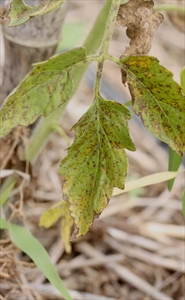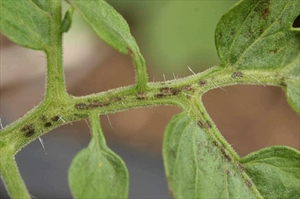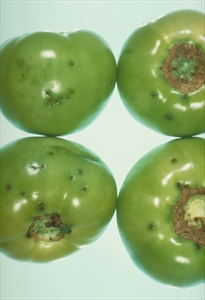Bacterial spot of tomato and pepper, bacterial scab, black spot
Pacific Pests, Pathogens, Weeds & Pesticides - Online edition
Pacific Pests, Pathogens, Weeds & Pesticides
Tomato bacterial spot (081)
Xanthomonas vesicatoria. Previously, Xanthomonas campestris pv. vesicatoria. Several strains are recognised, infecting tomato, pepper or both.
Asia, Africa, North, South and Central America, Europe, Oceania. It has been recorded from Australia (capsicum, tomato), American Samoa (tomato), Cook Islands (capsicum), Federated States of Micronesia (tomato, capsicum), Fiji (capsicum, potato, tomato, Solanum weeds), New Caledonia, New Zealand, Palau (capsicum, tomato), Solomon Islands (tomato), and Tonga (capsicum).
Tomato, capsicum, chilli, and weeds in the Solanaceae family, for instance, Datura, Physalis (cape gooseberry) and Nicotiana (tobacco) species.
The spots are small, numerous (Photo 1), sunken on the upper leaf surface, and slightly raised below. Single spots are up to 3 mm; merging, especially at the leaf tips and margins, and leaves look scorched and turn yellow; sometimes the lower leaves die and fall. Spots on the leaf stalks and stems are elliptical (Photo 2). Spots occur on the young fruits as raised scabs (Photo 3).
The bacteria infect leaves through natural openings; fruit are infected through wounds, which occur when fruits rub together or when bitten by insects.
There are several ways that the bacteria spread:
- To new plantings: on infected seed, and also from bacteria surviving in the soil in the remains of the last crop.
- Between plants: by rain splash, by overhead irrigation, or by hand watering when soil is splashed onto the leaves; spread is also by touching or handling wet plants.
- Between crops in different gardens: in mists produced by wind-blown rain or irrigation water.
- To seedlings: by seedborne bacteria, or bacteria in the nursery soil.
Bacterial spot survives between crops in crop remains, soil, on seed, and on wild hosts.
Bacterial spot is a serious disease. It is especially severe in warm, wet and windy conditions, causing plants to lose their leaves. Damage to fruit occurs (i) when the disease comes early as mostly young fruit are infected; and (ii) when leaves drop exposing the fruit to the sun.
Look for many small (2-3 mm) irregular spots on the leaves, leaf stalks, stems and fruits. Spots on the leaf stalks and stems are elongate, i.e., longer than they are wide. Look for scabby spots on the fruits with transparent margins.
Control of bacterial spot relies on: (i) growing healthy plants from seed free from infection, and (ii) care in handling seedlings when transplanting them from nursery to field.
Cultural control is important, as it is difficult to control this disease with chemicals. Not only are the chemicals expensive, but also they are easily washed off leaves and fruits in heavy rain showers that occur frequently in Pacific island countries.
CULTURAL CONTROL
Before planting:
- Do not use seed from infected plants; obtain a new source - those sold in commercial packets from reputable companies are most likely to be free from infection.
- If farmers want to use their own seed, but avoid seedborne infection, treat seed with hot water at 50°C for 25 minutes, cool and then dry1. But use a thermometer and treat the seed for the correct length of time.
- Make tomato nurseries far from tomato fields to prevent infection of seedlings.
- Carefully inspect every seedling before taking them to the field; remove and burn any seedlings with leaf spots.
- Remove weeds within tomato crops, and at the borders; and remove self-sown tomato plants before planting the crop.
During growth:
- Avoid overhead irrigation in favour of flood, furrow or trickle irrigation; if this is not possible, make sure irrigation is done early in the day so leaves are dry before evening.
- Avoid splashing water onto the leaves if hand watering.
- Apply a thick mulch around the plants to stop water from splashing bacteria from the soil onto the leaves.
- Do not work in the crop when plants are wet, as the disease can be spread on clothes.
After harvest:
- Collect plant debris after final harvest, and burn it.
- Do not plant tomatoes continuously: leave 2-3 years between crops on the same land, and do grow pepper or eggplant in the rotation.
RESISTANT VARIETIES
There are resistant varieties of capsicum.
CHEMICAL CONTROL
Use copper fungicides, or copper plus mancozeb. It is very important to have healthy seedlings free from bacterial spot, so spraying should start in the nursery, and continue at 7-10 day intervals in the field. Spraying early, when the plants are young, is especially important as in wet, windy weather, sprays alone often fail to give adequate control.
____________________
When using a pesticide, always wear protective clothing and follow the instructions on the product label, such as dosage, timing of application, and pre-harvest interval. Recommendations will vary with the crop and system of cultivation. Expert advice on the most appropriate pesticide to use should always be sought from local agricultural authorities.
AUTHORS Helen Tsatsia & Grahame Jackson
Information CABI (2014) Xanthomonas vesicatoria (bacterial spot of tomato and pepper). Crop Protection Compendium (https://www.cabi.org/cpc/datasheet/56981); and from EPPO (2021) Xanthomonas vesicatoria (XANTVE). EPPO Global Database (https://gd.eppo.int/taxon/XANTVE); and from (with Photo 3) Diseases of vegetable crops in Australia (2010). Editors, Denis Persley, et al. CSIRO Publishing. 1An alternative treatment is to soak seed in 1.3% solution of sodium hypochlorite for 1 min, then rinse and dry.
Produced with support from the Australian Centre for International Agricultural Research under project PC/2010/090: Strengthening integrated crop management research in the Pacific Islands in support of sustainable intensification of high-value crop production, implemented by the University of Queensland and the Secretariat of the Pacific Community.






